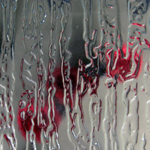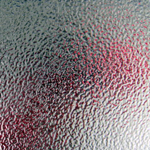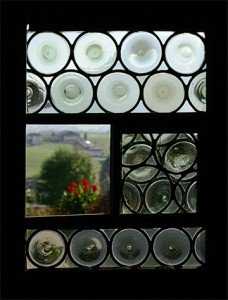A Short History of Window Glass
Around 100 AD, the Romans produced the first known glass used for windows, but it wasn’t until the early 17th century that glass became commonly used in windows of the everyday home in England. Early window panes were thick and small, made from uneven pieces of glass that allowed light in, but were not very transparent.
In the 1320’s, French glassblowers developed a process of making flattened pieces of glass by blowing a hollow globe, which was then spun into a flattened disk, called crown glass. The photo on the left shows Crown glass at the Angelika Kauffman Museum.
Around 1688 also in France, a procedure for manufacturing flat sheets of glass was developed. This involved pouring molten glass onto a table, then using rollers to evenly spread out the liquid glass.
As glazing technology improved and the plate process was mechanized, it became possible to fabricate larger, distortion-free pieces of glass. However, this process was costly as it required the finished glass to be ground and polished to remove the marks on the surface caused by roller to glass contact. It wasn’t until the 1950’s that a process for economically producing high quality, flat sheets of glass was devised.
Invented by Sir Alistair Pilkington, the float glass process involves combining the common raw materials of glass – including sand, soda and ash – and heating the mixture to about 1500°C. The molten glass is drawn from the furnace in a continuous ribbon and “floated” on a bed of molten tin. The result is a sheet of glass that is smooth and flat with a uniform thickness and perfect clarity. This method of fabricating glass is still used today.
Glass Choices — What a Pane
While the manner in which glass is made today hasn’t changed much in the past decades, modern technology has developed different types of glass enabling us to have better energy efficient windows and affording us a variety of choice in the appearance and safety of our homes.
ANNEALED GLASS
Float glass, or annealed glass, is the basic type of flat glass and is commonly used to make windows.
Annealed glass has a uniform thickness and allows for maximum natural light transmission without distortion. However, it tends to break in long, jagged shards and is not recommended for use in high traffic areas where safety is a concern. Annealed glass can be tempered and/or laminated.
TEMPERED OR HEAT-STRENGTHENED GLASS
 Tempered glass – or heat-strengthened glass, as it is sometimes referred to – is one of two kinds of safety glass. It is recommended for use where glass breakage could pose a danger. Standard annealed glass sheets are “tempered” by a process of extreme heating and rapid cooling.
Tempered glass – or heat-strengthened glass, as it is sometimes referred to – is one of two kinds of safety glass. It is recommended for use where glass breakage could pose a danger. Standard annealed glass sheets are “tempered” by a process of extreme heating and rapid cooling.
This process renders the glass sheets four to five times stronger than before. The hardened glass, when broken, shatters into small, dull pieces instead of long shards which eliminates the danger of sharp or jagged edges.
Tempered glass is used to make skylights, glass doors, store windows, tub enclosures and shower doors. Since the process of tempering also makes the glass heat-resistant, tempered glass is also used in household items such as glass teapots and coffee carafes, baking dishes, and oven doors.
LAMINATED GLASS
 Laminated glass, another type of safety glass, is made by a process that combines heat and pressure to bond a layer of polyvinyl butryal (PVB) between two or more layers of annealed, tempered, or heat-strengthened glass. This bonding process results in a highly strengthened glass pane that is impact-resistant and very durable.
Laminated glass, another type of safety glass, is made by a process that combines heat and pressure to bond a layer of polyvinyl butryal (PVB) between two or more layers of annealed, tempered, or heat-strengthened glass. This bonding process results in a highly strengthened glass pane that is impact-resistant and very durable.
When laminated glass breaks, it cracks into a spider web pattern, but the glass fragments are held in place by the PVB interlayer which prevents the glass from falling free and potentially causing injury. It also effectively reduces noise, blocks 99% of ultraviolet rays, and is used in windshields, highrise windows, skylights, glazed doors, balcony railings, elevators, etc. Laminated glass can be used for the outer panes of an insulating glass unit especially where safety or security is required.
LOW EMISSIVITY GLASS
In order to increase the energy efficiency, one or more of the glass window surfaces can be treated with special low emissivity (LoE) coatings. LoE is a thin, nearly colorless metallic coating that allows most of the light from the sun to enter freely through the window while absorbing a significant portion of the sun’s short-wave heat energy. In the summer, long-wave heat energy radiating from the sun is reflected back outside, helping to keep the inside cool. In winter, internal long-wave heat energy is reflected back inside, keeping the interior warm and lowering heating costs.
OBSCURE GLASS

 Sometimes called patterned glass, obscure glass adds privacy where window coverings are not practical or desirable. Various colors and texture patterns provide a translucent or semi-opaque effect that allows maximum light while maintaining privacy, and adds a decorative element as well. Obscure glass can also be tempered for use where safety glass is required.
Sometimes called patterned glass, obscure glass adds privacy where window coverings are not practical or desirable. Various colors and texture patterns provide a translucent or semi-opaque effect that allows maximum light while maintaining privacy, and adds a decorative element as well. Obscure glass can also be tempered for use where safety glass is required.
Shown here are examples of two of the most common types of obscure glass: rain and pinhead. Rain glass is most commonly used in bathroom windows.
TINTED GLASS
Glass is available in a variety of tints which increases privacy, absorbs some of the sun’s short-wave heat energy, and reduces the glare from the sun. Tinted glass changes the color of the window, but generally blends in well with other exterior colors. From the inside, tinted windows retain their transparency although the brightness of the view is diminished and the color is slightly changed. The most common tint colors are bronze, grey, blue and green.
For more information on glass options for your EuroLine windows and doors, visit our showroom or call and speak to our knowledgeable sales representatives.
Check out the links below for more information about window glass:
Shattering Science and Glass Physics
Check Out EuroLine’s Glass Options
Sign up for our eNewsletter for all our news, events and information.

